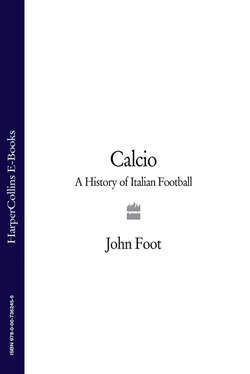Читать книгу Calcio: A History of Italian Football - John Foot - Страница 17
Violence and Fans. The early years
ОглавлениеViolence was part of calcio from the very beginning. Fights in the crowd were reported during the first ever championship tournament, the one-day affair in Turin in 1898, and violence began to afflict the game almost from the start. Football historian Ghirelli writes of pitch invasions during a match between Genoa and Juventus in 1905, which led to an immediate replay, and of stone-throwing during other early games.16
Between 1911 and 1914, a number of incidents marred games. Stones were hurled at a referee in 1912 in a match between Genovese team Andrea Doria and Inter. In December 1913 another referee was forced to run away from angry supporters in a match at Novara. A photo survives of this incident, depicting a number of men with straw hats milling around on the pitch, and a bemused goalkeeper-onlooker. Casale and Inter fans fought each other on the pitch in June 1914. Some of this violence was linked to actual games, some to local rivalries, and some to gambling, which was already widespread. Pitch invasions became commonplace, such as in a match between two Rome teams in June 1914 and in a Tuscan match in January of the same year, when shots were fired and stones thrown during a Livorno—Pisa derby.
In the brutal atmosphere of post-war Italy, football violence exploded on and off the field. For Ghirelli, there was a series of episodes that ‘veered between farce and the time of the Wild West’.17 Rinaldo Barlassina, one of the most prominent Italian referees at the time, was the victim of stone-throwing during a match at Casale. After refusing to give a penalty, Barlassina used an umbrella to protect himself and he emerged unhurt. Ghirelli comments that ‘it is unclear if this was thanks to his stoicism or to the fact that the stones had run out’.18 Another referee was attacked by angry fans on his way home after a game at Modena.
In February 1920, a pitch invasion interrupted Pro Vercelli-Genoa and Guido Ara, a Vercelli midfielder, was hit by an angry fan. A rare photo survives of this incident, with supporters running towards the referee whilst the players flee. In the background, a number of fans have clambered up trees in order to see the match. In 1921 Pro Vercelli were again involved, this time against Inter, in Milan. In the first half, an Inter player was seriously injured. The home crowd blamed Vercelli’s players. In the second half the atmosphere was ‘electric’ but Vercelli continued their ‘dirty play’, according to press reports. Finally, Vercelli’s captain was sent off. Another injury followed – this time a broken leg – and the players squared up to each other. After a pitch invasion the referee took refuge in the dressing room. The Vercelli player blamed for the incidents was banned for six months and the match was never replayed.
Footballers also became directly involved in the political violence which tormented Italy after the war. Aldo Milano, 24, was the third of four brothers who all played for Pro Vercelli before and after the war. Milano the Third, as he was known, was also a militant fascist. One night, in January 1921, a group of Vercelli fascists decided to visit another nearby town to carry out a mission – the removal of a plaque that was seen as insulting to the war dead. Symbols were important in post-war Italy, and could get you killed. Socialists cried ‘down with the war-mongers’ and attacked those seen as responsible for the conflict, whilst nationalists and fascists flew the Italian flag and exalted the ‘heroes’ from the trenches. That fateful night, Milano the Third was helping the others remove the plaque in question when a local government doorkeeper shot him. Here, as ever, versions differ. Some claim that he was taken to hospital, but nothing could be done; others that his body was left on the street all night.
Aldo Milano had played just over twenty games for Pro Vercelli, who threatened to abandon the championship altogether before deciding to continue. Local fascists were quick to exploit the death of Milano, making him into the latest of a series of ‘fascist martyrs’, and the local fascist branch was immediately renamed in his honour. As on other occasions, the fascists ‘organized commemorations…through which they tried to wipe out the memory of the socialist dead, whose numbers were far greater’.19 This time, the setting for these commemorations was a football pitch.
The most violent calcio-related moment of the whole post-war period was connected to football, but was not really about football. Viareggio’s ‘red days’ of 1920 reflected the spirit of the times. In this dramatic case, football was more of an excuse for, and not the cause of, the violence.
